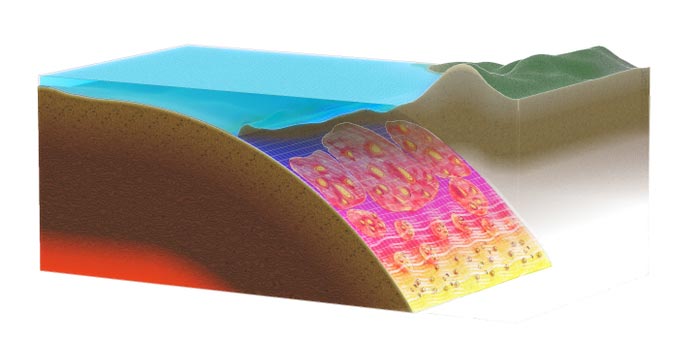Slow slips offer insights into earthquakes

In a subduction zone where two tectonic plates collide, slow slip events or silent earthquakes can occur. Although these events do not pose a threat, they can trigger earthquakes nearby.
Credit: © 2021 KAUST; Heno Hwang
Significant earthquakes, from gentle shaking to devastating tremors, are hazards caused by a sudden release of stress that has built up in geological faults. More subtle events called slow slips are attracting increasing attention as nonshaky versions of the dramatic seismic fractures of the largest earthquakes.
A database of information on previous slow slips to develop a model of the mechanisms of these geological events has now been compiled by KAUST and University of Geneva researchers, in collaboration with colleagues at ETH in Switzerland, GFZ in Germany and the University of Bologna in Italy.
Slow slips, also known as silent earthquakes, are fractures of the Earth’s crust that propagate very slowly without producing seismic waves. They typically proceed over a few weeks or months, and their duration can range from less than a day to more than a year.
“Slow slips alone pose no threat since they don’t generate shaking and therefore cause no damage or disruption to properties, but they cause disturbances that can trigger regular earthquakes nearby,” says Luigi Passarelli, formerly of KAUST and now in ETH in Switzerland.
The potential of triggering regular earthquakes is one reason why researchers are keen to learn more about slow slip events. Another reason is that they come with smaller tremors or sometimes a flurry of small earthquakes, a so-called seismic swarm, in a process not yet fully understood.
Slow slip events occur in many regions where tectonic plates collide and slide but especially in subduction zones around Japan, New Zealand and North and Central America. They also occur near volcanoes such as Mt. Etna in Italy and Kilauea in Hawaii.
“We have compiled the first systematic catalogue of the aseismic and seismic characteristics of slow slip events to better understand the physical mechanisms that generate both,” says Passarelli. He adds that this was a big challenge as the data are not all consistently archived or readily available.
The results have allowed the team to assess the correlation between the characteristics of each slow event and the triggered tremor activity, as size and duration, and the likely immediate and possible long-term consequences. This information can now be used to improve a model to predict the changes and hazards associated with specific types of event.
“We have made a step toward an improved understanding of the processes that control slow slips and seismic tremors, although there is more to investigate,” says Passarelli. The researchers hope that their database and modelling can be developed further to build a better understanding of those complex processes.
Journal: Science Advances
DOI: 10.1126/sciadv.abg9718
Method of Research: Computational simulation/modeling
Subject of Research: Not applicable
Article Title: The source scaling and seismic productivity of slow slip transients
Article Publication Date: 4-Aug-2021
All latest news from the category: Earth Sciences
Earth Sciences (also referred to as Geosciences), which deals with basic issues surrounding our planet, plays a vital role in the area of energy and raw materials supply.
Earth Sciences comprises subjects such as geology, geography, geological informatics, paleontology, mineralogy, petrography, crystallography, geophysics, geodesy, glaciology, cartography, photogrammetry, meteorology and seismology, early-warning systems, earthquake research and polar research.
Newest articles

First-of-its-kind study uses remote sensing to monitor plastic debris in rivers and lakes
Remote sensing creates a cost-effective solution to monitoring plastic pollution. A first-of-its-kind study from researchers at the University of Minnesota Twin Cities shows how remote sensing can help monitor and…

Laser-based artificial neuron mimics nerve cell functions at lightning speed
With a processing speed a billion times faster than nature, chip-based laser neuron could help advance AI tasks such as pattern recognition and sequence prediction. Researchers have developed a laser-based…

Optimising the processing of plastic waste
Just one look in the yellow bin reveals a colourful jumble of different types of plastic. However, the purer and more uniform plastic waste is, the easier it is to…



